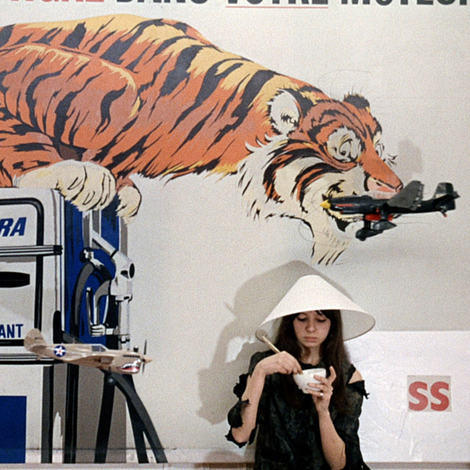In a quiet section of Paris, in the 13th Arrondissement, a large building with recessed columns, Romanesque windows, and caryatids preserves an ancient art. For four centuries the Gobelins Manufactory has made tapestries here, and today the government still pays dozens of weavers to carry on by hand. A selection of these woven artworks—some with starry names attached, such as Joan Miró, Henri Matisse, and Alexander Calder—has just landed at the Clark Art Institute, in Williamstown, Massachusetts, in an exhibition titled “Wall Power! Modern French Tapestry from the Mobilier National, Paris.”
As those names might suggest, the Gobelins weavers—as well as weavers in the cathedral town of Beauvais, north of Paris—are creating a new type of tapestry, one that trades historical scenes and fantastical figures for modern subjects.
Contemporary weavers can produce any type of image, from abstraction to photographic realism, which “Wall Power” demonstrates. All 32 of the tapestries on view were lent by the Mobilier National, an official French institution that owns antique and vintage furniture, décor, and other objects in the tens of thousands.

Tapestry-making’s turn from classicism to modern movements in art began in earnest in the 1930s. Clark curator of decorative arts, Kathleen Morris, who organized the show, says the change gave tapestries a new popularity after a time when they did little but mimic old themes.

In 1946, for example, the Mobilier invited Matisse to give Gobelins a design. The artist suggested one based on his 1943 painting The Lute, yet made substantial modifications to the image that tied it to the medieval glory days of tapestry. He framed the musician in a woven border—a frequent feature of classic hangings—and let bright red run riot, dominating tabletop, wallpaper, and carpet. Plant patterns and an outsize flower add sensuality to the musical scene.
Similarly, the design submitted by Marc Saint-Saëns, titled Orphée, echoes the old days by reviving a popular subject of the 15th and 16th centuries: the poet Orpheus charming wild animals with his music. The artist—the grand-nephew of Camille Saint-Saëns, who composed The Carnival of the Animals—had his weavers make the birds and beasts so vivid they seem to glimmer. Even more brilliant is the gleam surrounding naked Orpheus and his lyre: his figure is cobalt blue with an acid-yellow aura that sends out little green lightning bolts, a distinctly modernist styling, according to Morris. It’s a synesthetic image of music and poetry, their force portrayed monumentally at almost 10 feet high and 16 feet wide.

Morris grew to know and love recent tapestries only in the last few years, and “Wall Power” stems from two chance events: a view of a Matisse tapestry and a casual conversation with a staffer at the New York branch of the Villa Albertine, the French state’s outreach project for culture and education. Tapestries “have their own visual vocabulary,” Morris says. “They’re just magical.” And because of their scale on the wall, tapestries, unlike paintings, provide a separate textural experience that defines a room. Because they are laborious to make, Gobelins finishes a mere six to seven tapestries a year. Orphée took more than two years to weave.

Kiki Smith’s Seven Seas took six years. In 2012, the German-born American artist produced seven small aquatint etchings of black oceans and colored rocks under mostly troubled skies, each one six-by-nine inches with a wide border. The tapestry based on one of these images is 9 by almost 14 feet wide and an object lesson in the power of scale. Smith says she still hasn’t seen the large version and will do so when she visits the exhibition. As Morris points out, the image of the rock, assaulted by giant waves, threatened by the most ominous of clouds, reads of apocalypse, earth gone haywire. Tapestries have it in them to shock.
“Wall Power! Modern French Tapestry from the Mobilier National, Paris” is on at the Clark Art Institute, in Williamstown, Massachusetts, until March 9
Peter Saenger has written and edited for The Wall Street Journal on such topics as art, art books, museums, and travel. His fiction has appeared in The New Yorker


